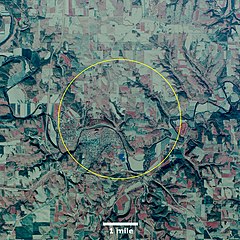Decorah crater
| Decorah crater | |
|---|---|
 Location of Decorah crater on bedrock map of Iowa | |
| Impact crater/structure | |
| Confidence | Potential[1] |
| Diameter | 3.5 mi (5.6 km) |
| Age | ~470 Ma Middle Ordovician |
| Exposed | No |
| Drilled | No |
| Bolide type | Ordovician meteor event? |
| Location | |
| Coordinates | 43°18′50″N 91°46′20″W / 43.31389°N 91.77222°W |
| Country | United States |
| State | Iowa |
| District | Winneshiek |
| Municipality | Decorah |
The Decorah crater, also called the Decorah impact structure, is a possible impact crater located on the east side of the city of Decorah in Iowa, United States. It is thought to have been caused by a meteor about 200 metres (660 ft) wide which struck during the Middle Ordovician Period, circa 470 million years ago.
Description
The crater is estimated to be 3.5 miles (5.6 km) in diameter, covered by the Winneshiek Shale.[2][3][4] There is no surface evidence of the impact, as the Winneshiek Shale is more than 50 feet (15 m) below the bottom of the Upper Iowa River. The impact event, equivalent to 1,000 megatons of TNT,[3] did not appear to penetrate the Earth's mantle, but it did push down the underlying Ordovician and Cambrian bedrock several hundred feet.[5] It may be one of several Middle Ordovician meteors that fell roughly simultaneously 469 million years ago, part of a proposed Ordovician meteor event, including three confirmed impact craters: Rock Elm crater in Wisconsin, Slate Islands crater in Lake Superior, and Ames crater in Oklahoma.[6]
Pentecopterus decorahensis
The Middle Ordovician (Darriwilian) Winneshiek Lagerstätte sediments that filled in the crater contained a wide variety of unusual fauna. Among them was a newly discovered species of eurypterid, Pentecopterus decorahensis. Pentecopterus was scorpion-like in appearance, and the largest predator known from that time, measuring nearly 6 feet in length. Its species name was derived from "Decorah."[7]
See also
References
- ^ Mikheeva, Anna (2017), The Complete Catalog of the Earth's Impact structures, Russian Academy of Sciences, p. 1, retrieved 2017-10-14
- ^ Vastag, Brian (18 February 2013). "Crater found in Iowa points to asteroid break-up 470 million years ago". The Washington Post. Retrieved 19 February 2013.
- ^ a b "Geological survey: Ancient meteorite crater sits below Decorah". Cedar Rapids Gazette. 5 March 2013. Retrieved 6 March 2013.
- ^ US Geological Survey. "Iowa Meteorite Crater Confirmed". Retrieved 7 March 2013.
- ^ Iowa Department of Natural Resources. "GEOLOGIC MAPPING FOR WATER QUALITY PROJECTS IN THE UPPER IOWA RIVER WATERSHED" (PDF). Technical Information Series No. 54, 2011. Retrieved 19 February 2013.[permanent dead link]
- ^ Heck, Philipp; Birger Schmitz; Heinrich Baur; Alex N. Halliday; Rainer Wieler (15 July 2004). "Fast delivery of meteorites to Earth after a major asteroid collision". Nature. 430 (6997): 323–325. Bibcode:2004Natur.430..323H. doi:10.1038/nature02736. PMID 15254530.
- ^ Lamsdell, James C.; Derek E. G. Briggs; Huaibao P. Liu; Brian J. Witzke; Robert M. McKay (2015). "The oldest described eurypterid: a giant Middle Ordovician (Darriwilian) megalograptid from the Winneshiek Lagerstätte of Iowa". BMC Evolutionary Biology. 15 (169): 169. Bibcode:2015BMCEE..15..169L. doi:10.1186/s12862-015-0443-9. PMC 4556007. PMID 26324341.







